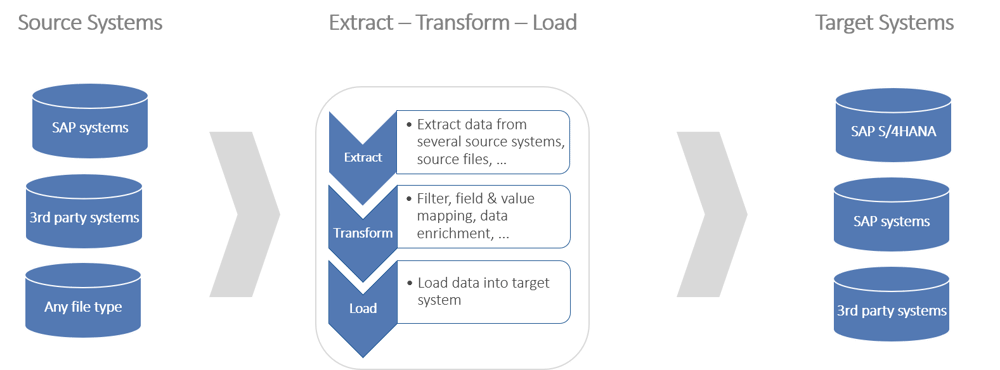When companies implement new business software such as an ERP system, they need to move their data from the old system to the new one. Often, however, insufficient attention is paid to data migration – resulting in project delays, higher costs and a negative impact on day-to-day operations. To prevent this, it is crucial to design the data migration in detail and to obtain a precise overview in advance of what data is to be migrated and what resources are required for this.
Want to get your data ready for migration?
Careful analysis before data migration
The basis of any data migration project is detailed knowledge of the data and processes involved. Therefore, a careful analysis of the company’s own data and processes is recommended even before the data migration. The goal is to create maximum transparency and avoid unforeseen surprises in the further course of the data migration.
The data migration process is relatively similar in every project. It is about bringing a certain amount of data from one or more source systems into the target system. This is usually done according to the ETL principle (extract – transform – load): The data is first extracted from the source, then prepared for the target structure and finally transferred to the target system. Various ETL tools are available that support the data migration based on best practices. These include, for example, the SAP S/4HANA Migration Cockpit and SAP Data Services.
With the right strategy to migration success
A data migration has the greatest chance of success if companies develop an appropriate strategy in advance, which they can use as a guide during the project. It serves the purpose of creating a common target image for the business unit and gaining the acceptance of colleagues. Involving the specialist department as early as possible also contributes to this. Training sessions familiarize the departmental colleagues with the benefits of the new system and ensure that they support the changes.
In addition, the data migration strategy should help to avoid typical sources of errors that can have a detrimental effect on the project. These can be inaccurate data, problems in the source data or an unexpectedly complex target system. With the help of a suitable strategy, it is easier to ensure that the data migration goes well and to avoid time and budget overruns.

Typical process of a data migration
What is important in data migration?
Due to its complexity, data migration should be considered as a separate project or stream running in parallel with the main system implementation project. During the review of source data, data cleansing should also take place, during which data quality is increased and duplicates are eliminated, for example. Equally important are the scope definition – i.e., clarifying which data should be taken along – and the planning of the necessary resources. Once the new system has been implemented, effective controls and mechanisms must be put in place to ensure that data quality remains high after the migration.
Different source and target structures in the systems can present a challenge. If the data is outside the required value range, appropriate mapping is required. A typical example of this in the SAP environment is the conversion from a two-digit to a three-digit country code. When analyzing the source data, companies may come to the conclusion that the data quality does not meet current requirements and processes. One possible solution is to enrich the data by connecting external sources. Archiving concepts are an option for obsolete master data records: The data is usually initially retained for a certain transition period, with a deletion flag set for archiving. After the transition period has expired, the data is finally deleted.
Consider dependencies
Normally, a data migration does not take place in isolation, but is embedded in a larger project, which results in certain dependencies. Currently, many companies are dealing with data migration as part of the introduction of SAP S/4HANA. This should be seen as an important element of the overall project, which requires coordination with the other streams of the project. For example, colleagues need to be supplied with data when they perform integration tests.
To ensure a smooth process and seamless integration into the overall SAP S/4HANA project, a precise concept for data migration should be in place. First and foremost, this includes a target scenario, which usually corresponds to the target scenario of the SAP S/4HANA implementation. The exact scope of the data migration must also be defined in the concept. In addition, the migration environment must be determined: Which tool should be used to perform the migration? As far as the technical implementation is concerned, different numbers of cycles must be planned depending on the type and number of migration objects. The question of whether only master data or also transaction data is migrated is also relevant here. Finally, it is a question of defining criteria for acceptance in order to assess whether the data migration was successful.
Conclusion: Early planning leads to the goal
One of the crucial success factors of a data migration is to start with the conception as early as possible when the introduction of a new system such as SAP S/4HANA is on the agenda. To create a high level of acceptance for the migration project, the affected colleagues from the business department should be involved at an early stage. After all, they are the ones who work with the data on a daily basis. This also ensures that the necessary resources are available. Data migration should always be considered a stand-alone project or an independent stream within the main project. Performing backups is essential to avoid data loss. And intensive testing after each completed cycle is also an essential part of making the data migration a success.
![IBacademy_Logo_blau[496] IBacademy_Logo_blau[496]](https://www.ibsolution.com/hs-fs/hubfs/IBacademy_Logo_blau%5B496%5D.jpg?width=200&name=IBacademy_Logo_blau%5B496%5D.jpg)




